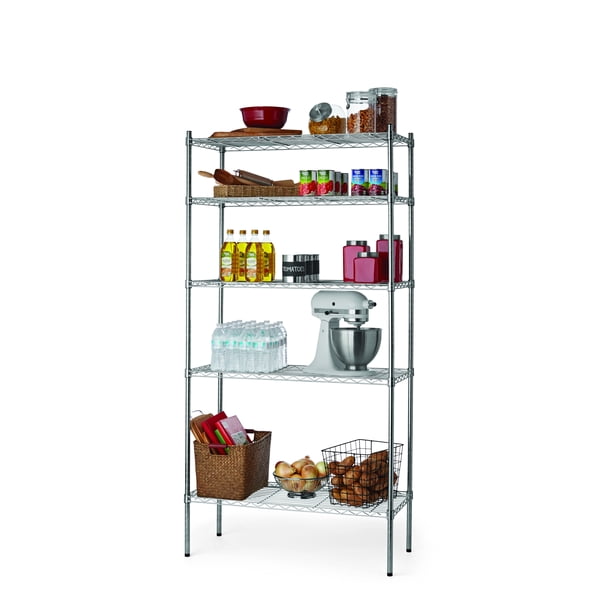Hyper Tough 5 Tier Wire Shelf, Zinc, 1750 lb Capacity
Commercial grade steel construction. Easy assembly with no tools required. Chrome color. Shelves adjust in 1 inch increments. Adjustable feet levelers for uneven floors.
Hyper Tough 5 Tier Wire Shelving Rack is perfect for all your organizational needs. It has strong and durable welded wire construction. Open wire design allows air circulation and reduces dust build-up. Shelves can be adjusted in 1 inch increments and can hold up to 350 lbs. evenly distributed. This wire shelving system is perfect for homes, offices, warehouses, kitchens, restaurants and any other places you need to organize.
- Commercial grade steel construction
- Easy assembly with no tools required
- Chrome color
- Shelves adjust in 1 inch increments
- Adjustable feet levelers for uneven floors
- Assembled size: 16″Dx36″Wx72″H
- Weight capacity per shelf: 350 lbs evenly distributed
- Total unit capacity: 1750 lbs
- NSF certified for dry storage applications
- 5-Year Limited Warranty
- Model#B35Z-2
Additional information
| Manufacturer Part Number | B35Z-2 |
|---|---|
| Assembled Product Weight | 32.1874 lb |
| Assembled Product Dimensions (L x W x H) | 16.00 x 36.00 x 72.00 Inches |






by Mike
I was lucky to get it for the price of $38 and it’s bigger than it appears on the box.
by Lizzy
My kids like it, now they can organize their rooms and I don’t have to pick up their messy toys and stuff. It’s good for shelving but I don’t think it can be stored up to 1750 lbs, no way.
by Brittney
I was looking for a nice set of shelves for our garage but they are so expensive. I had really considered buy plastic ones until I came across these. I purchased 2, set them up and went back to buy a 3rd set but they were sold out. I truly wish I had purchased another but I’m super happy with the 2 we have. Also the assembly was super easy. I put both of them together with in 45 minutes. No tools are needed but I would recommend a rubber hammer to ensure connection. Overall 5 stars, Will buy again if they restock them.
by Josh
I have at least six of these units. Most of them have been perfect, but sometimes a shelf is slightly bent- good thing I have a vise in my shop! These are easy to assemble and disassemble; all you really need is a rubber mallet for either task. This shelf unit also works well as two 3 foot tall shelving units (I use inexpensive handle bar plugs to cap off any open pole ends) I will soon replace all wooden shelves in my house with these. I prefer the 36″ width to the 48″ width.
by Handiman
I have other wire shelving and this unit is smaller, i.e., the shelves are about 1 inch thick but my other shelves are about 1.2 inches thick. The pole diameters are smaller too. The chrome plating is not very good. It varies from dull to shiny and some of the shelves have a platinum tint to them. I wonder how long will the plating last. The shelves are strong but 350 lbs per shelf is a bit of a stretch. 200 lbs maybe. The long wires are not welded to the ends of the shelves but to the few short cross bars. All I can say is, it works and for a garage, it’s pretty good.